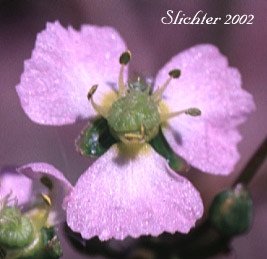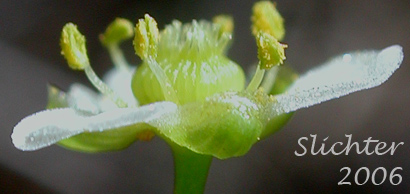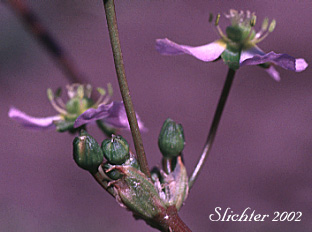

 The
photo at right shows a close-up view of the underside of the petals and sepals of American waterplantain as seen along the Old Highway about one mile east of Major Creek in the central Columbia River Gorge........July 7, 2006.
The
photo at right shows a close-up view of the underside of the petals and sepals of American waterplantain as seen along the Old Highway about one mile east of Major Creek in the central Columbia River Gorge........July 7, 2006.
American waterplantain is a semiaquatic perennial wildflower with one flower stem arising up to one meter from a cluster of basal leaves. The leaves are shorter than the flower stem. The blades are ovate to oblong or oblong-lanceolate and 5-15 cm long and 3-15 cm wide. The leaf bases are rounded to somewhat heart-shaped. The petioles are 2-4 times longer than the blades and channeled.
The flower stem is much branched, forming a compound panicle. The flowers are arranged in whorls of 3 terminal panicles per node. The flowers are arranged in clusters of 3, with 3 white to pinkish petals from 4-6 mm long and broadly obovate in shape with subentire to toothed tips (See photo above.). The flowers are 6-9 mm wide. The 3 green sepals are broadly obovate to orbicular in shape. The 6 stamens are shorter than the petals and 10-25 separate ovaries are found in the middle of the flower.
American waterplantain may be found in water or wet places from the lowlands to moderate elevations in the mountains.
American waterplantain may be found from southern British Columbia south to southern California and east to Nova Scotia, Maine, New York, Missouri, Colorado and Arizona. It is also found across much of Eurasia, Africa, and Australia.
In the Columbia River Gorge it may be found between the elevations of 0'-1800' throughout the length of the Gorge.

